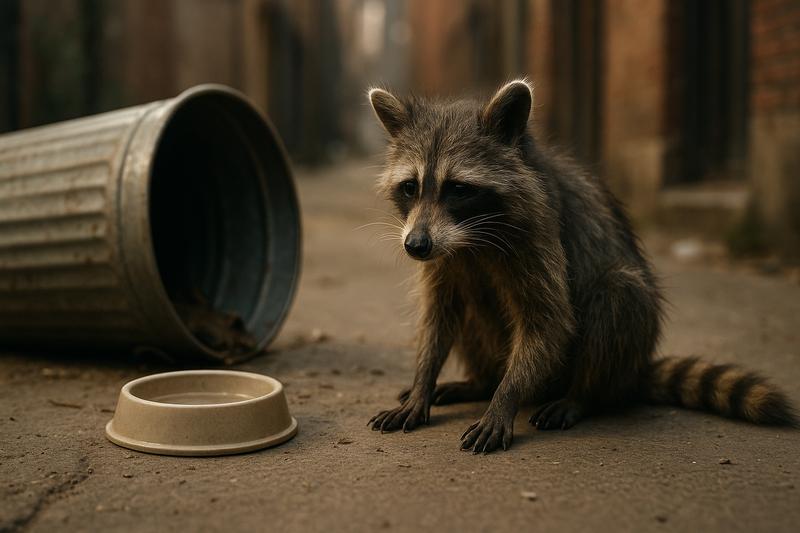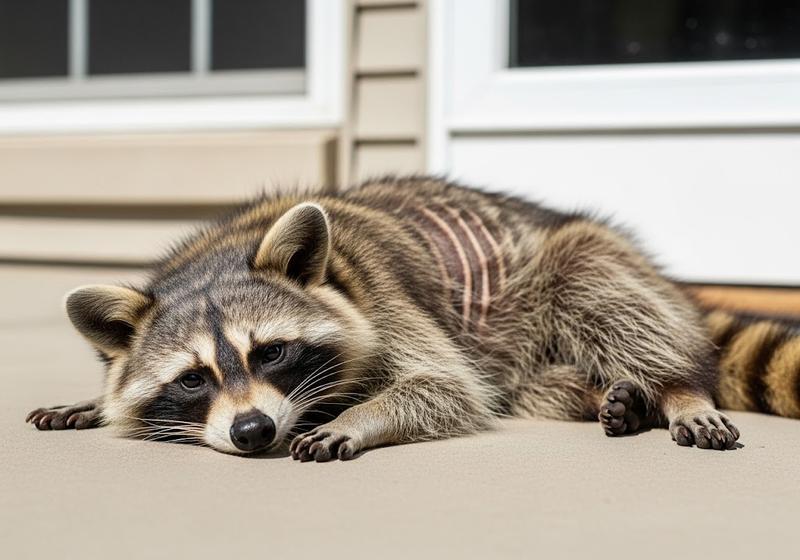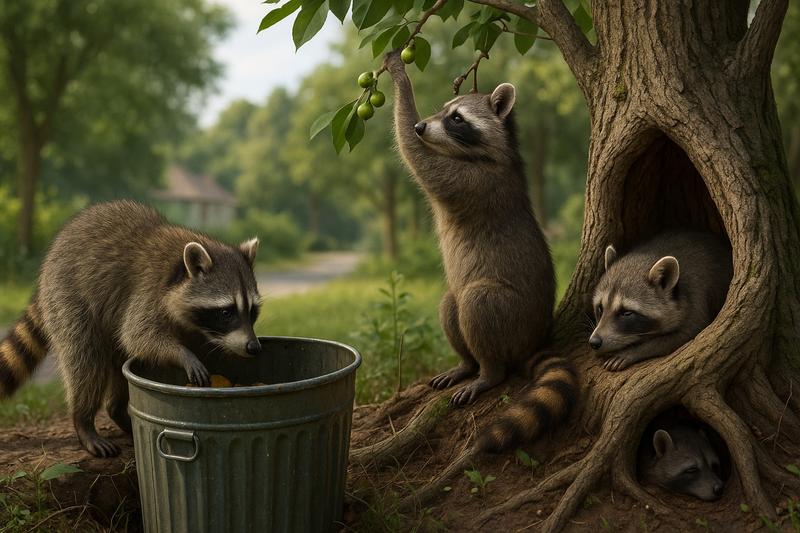How Long Can Raccoons Survive Without Food or Water?

A healthy raccoon can survive up to 2 weeks without food, but only 3–5 days without water, and even less in hot conditions. These survival limits depend on the season, the raccoon's health, and whether it enters a state of torpor (a light hibernation) in winter. If you've come across a raccoon that appears sick, weak, or trapped, it's crucial to understand what it's going through, and how to help responsibly.
In this guide, we’ll explain exactly how long raccoons can survive without food or water, the signs they’re in distress, and the humane steps you can take to help.
Quick Answer: Food vs. Water Survival Time
Raccoons, like most mammals, can go longer without food than they can without water. Here's what wildlife experts and rehab centers generally observe:
-
Without water: 2-4 days in warm conditions. In hot weather, dehydration can set in rapidly and may become fatal within 72 hours.
-
Without food: 7-14 days depending on the raccoon's body fat, activity level, and environmental conditions.
-
During torpor (winter survival): Raccoons slow their metabolism and can last for weeks with minimal food intake.
A raccoon stuck in an attic or shed might go unnoticed for days. If it has no access to drinking water and cannot escape, dehydration becomes life-threatening far faster than starvation.
Factors That Affect Raccoon Survival
Several biological and environmental factors influence whether a raccoon can endure several days without nourishment—or if it declines quickly.
Body Condition and Fat Reserves
Raccoons store body fat during fall in preparation for leaner winter months. A well-fed raccoon in autumn may survive longer without food than a summer raccoon with minimal reserves. Juvenile raccoons or elderly individuals are especially vulnerable due to lower energy storage.
Season and Temperature
In cold weather, raccoons enter a state of torpor. This is not true hibernation, but a deep sleep that slows their metabolism and conserves energy. During torpor, a raccoon might last 2–3 weeks with only minimal foraging. In contrast, hot summer days drastically reduce survival time without water. Heat accelerates fluid loss, increasing dehydration risk.
Age and Health
Young raccoons still dependent on their mother cannot survive more than a few days without her. Older raccoons or those with illnesses (like distemper or parasites) have weakened systems and may succumb to stress or dehydration faster than healthy adults.
Signs of Dehydration or Starvation
If you see a raccoon acting strangely or showing signs of decline, knowing what to look for can help you decide whether to call a professional.
Behavioral Signs
- Active during daylight hours (unusual for nocturnal raccoons)
- Uncoordinated movements or wobbling
- Circling or appearing disoriented
- Entering areas humans frequent, like porches or driveways
Physical Signs
- Sunken or glassy eyes
- Visible rib cage or spine
- Lethargy or collapse
- Labored breathing or excessive panting
In particular, dehydration affects organ function and neurological activity. A dehydrated raccoon may appear confused or too weak to move. Starvation is slower and might only become visible after a week, but both require intervention.

A dehydrated, starving raccoon often appears weak, with sunken eyes, visible ribs, and unusual daytime activity.
What to Do if You Find a Trapped Raccoon
You may find a raccoon trapped in a dumpster, attic, garage, or behind a fence. These animals are opportunistic and curious—but they don’t always find their way back out.
If the Raccoon is Stuck or Weak
- Do not attempt to handle the raccoon. Even if it seems weak, raccoons can bite or scratch when frightened. They also carry diseases like rabies and leptospirosis.
- Observe from a distance. Take note of the raccoon’s condition, location, and whether it can move.
- Call a licensed wildlife rehabilitator or local animal control. These professionals know how to safely remove and assess the raccoon.
- Avoid feeding it directly. While well-intentioned, offering food or water can stress the animal further or cause choking.
If the animal is in immediate danger (for example, exposed in the sun or trapped in wire), call emergency wildlife rescue services. Many operate 24/7 in urban and rural areas.
Humane and Legal Options
In most regions, it is illegal to relocate or kill wildlife without proper licensing. Humane approaches—such as calling a wildlife rescue or using one-way exit doors—are preferred and often required by law. Pest control companies may not always prioritize animal welfare, so it’s better to contact an organization that specializes in wildlife rehabilitation.
How Raccoons Adapt in the Wild
Raccoons are natural survivors. Their ability to thrive in both forest and urban environments means they’ve evolved a flexible approach to finding food.
- Omnivorous scavengers: Raccoons eat fruits, nuts, insects, small animals, eggs, and garbage. Their diverse diet helps them weather seasonal scarcity.
- Urban strategies: In cities and suburbs, raccoons forage in trash cans, compost bins, and pet food dishes left outdoors. They’re incredibly dexterous and can open containers and unlatch gates.
- Torpor in winter: Rather than true hibernation, raccoons enter a low-energy sleep called torpor. During this time, they retreat into dens and move very little, occasionally waking to eat cached food or snow for hydration.
This flexibility helps raccoons survive short-term shortages. However, they still need consistent access to water—and once trapped or injured, they quickly decline.

Raccoons adapt to food shortages by scavenging in trash, foraging for fruits, and conserving energy through torpor.
FAQ: Raccoon Survival Without Food or Water
How long can a raccoon live without water?
In warm weather, a raccoon typically survives no more than 2–3 days without water. Dehydration causes rapid organ failure, especially in hot conditions. In cooler climates or shaded environments, survival may extend slightly, but 72 hours is often fatal without hydration.
Can raccoons survive without food for a week?
Yes. Healthy adult raccoons, especially those with seasonal fat reserves, can survive 7–14 days without food. Their omnivorous nature and adaptability help in short-term scarcity. However, after a week, energy depletion begins to affect vital functions.
Do raccoons hibernate?
Not exactly. Raccoons enter a state called torpor, not true hibernation. During winter torpor, they sleep for days or weeks, lowering their metabolism to conserve energy. This allows them to survive with minimal or no food intake for extended periods.
What should I do if I think a raccoon is starving or dehydrated?
Avoid direct contact. Feeding wild raccoons can cause harm or legal issues in some areas. Instead, contact a licensed wildlife rehabilitator or local animal control. They’re trained to handle distressed or malnourished raccoons safely and humanely.
Can baby raccoons survive without their mother?
Rarely. Orphaned baby raccoons rely entirely on maternal care. Without nursing and body warmth, they may die within 48–72 hours. If you see one alone for an extended time, contact wildlife rescue immediately.
How can I tell if a raccoon is dehydrated?
Common signs include:
-
Sunken or glassy eyes
-
Wobbling or disoriented movement
-
Panting or labored breathing
-
Visible ribs or weak posture
Such behaviors suggest critical dehydration or starvation, requiring expert intervention.
Do raccoons store food or water for later?
No. Unlike squirrels, raccoons do not cache food. They rely on daily foraging and opportunistic scavenging, especially in urban environments. During winter, they rely on body fat rather than stored food.
Why do raccoons survive better in cities?
Urban raccoons have access to trash bins, pet food, and water sources like gutters or birdbaths. Their problem-solving skills and dexterous paws help them find resources even during food shortages.
Know when to act-and how to help responsibly
Understanding how long a raccoon can live without food or water can help you make better decisions when you encounter a distressed animal. In general:
-
3 days without water is critical
-
7–14 days without food is possible but dangerous
-
Torpor extends survival in cold months
-
Symptoms like confusion or visible ribs indicate serious danger
If you think a raccoon is trapped, starving, or dehydrated, don't wait—call your local wildlife rescue center or animal services. It's the fastest, safest way to ensure the raccoon gets the help it needs.
Helping wildlife doesn’t always mean intervening directly. Sometimes, the best thing you can do is call someone trained to help—and let nature take its course with care and compassion.
This incredible resilience is part of what makes raccoons so fascinating. While we should always help them responsibly in the wild, we can also celebrate their survivor spirit every day. Show your admiration for these tough, clever creatures with our Raccoon Aesthetic Outfit collection, or find a playful nod to their mischievous side with our funny animal shirts.
Recent Posts
- How Long Do Raccoons Live? Wild vs Captive Lifespans Explained
- Are Raccoons Marsupials? Here's the Truth Behind the Confusion
- Are Raccoons Related to Bears? The Evolutionary Truth Explained
- Is a Raccoon a Rodent? The Truth About Their Classification
- 15 Animals That Look Like Raccoons and What Makes Them So Similar
- What Are Raccoons Good For? 4 Surprising Benefits You Should Know
- What’s a Group of Raccoons Called? Fun Facts & Rare Terms
- 20 Fun Facts About Raccoons That'll Surprise You
- Return Policy for Clothing Online: What You Need to Know
- How to Check the Quality of a T-Shirt Before Buying (2025 Guide)

